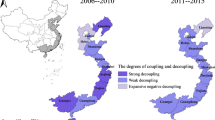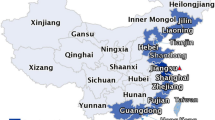Abstract
Environmental efficiency standards are often used to evaluate the costs of oceanic economic development. A variety of statistical analyses were applied in this study to quantify the marine environmental efficiency of 11 Chinese coastal provinces and municipalities between 2000 and 2014. Results initially reveal that environmental efficiency measures that incorporate undesirable outputs are more consistent with real production conditions and thus the use of marine economic and environmental efficiencies supplement and complement one another. Second, overall marine environmental efficiency across China tends to be low and can be spatially characterized by a transformation such that the inefficiencies noted in 2000 have subsequently been transformed to comprise a three-tiered structure that encompasses northern, central, and southern cores. Third, variation in absolute and relative marine environmental efficiency differences for the coastal regions of China have been consistent over time; values initially decreased before increasing again in a fluctuating manner over the time period of this analysis. Fourth, data show that the Pearl River Delta area has experienced the highest rate of change in marine environmental efficiency over time when economic zones are used as basic research units, although values have nevertheless fluctuated significantly. Fifth, values for total factor productivity as well as technical efficiency and change across the Chinese marine economy all fluctuated over time but increased. Data show that changes in marine environmental efficiency across China can primarily be attributed to progress in marine science and technology. Finally, levels of capital investment and marine industrial pollution intensity are not significantly correlated with marine environmental efficiency. Indeed, both marine industrial structural levels and environmental protection technologies have had a positive effect on environmental efficiency while levels of investment in marine scientific research as well as the scale of economic development, the marine economy, and the degree of external openness have all exerted negative effects on this key variable.
Similar content being viewed by others
References
Meng Wei, Shu Yimin, Zhang Linbo, 2015. China Engineering Science, 2015, 17 (8): 39–45. (in Chinese)
Bai Yongping, Zhang Xiaozhou, Hao Yongpei et al., 2013. Research on regional environmental performance and its influential factors based on SBM-Malmquist-Tobit model. Areal Research and Development, 32(2): 90–95. (in Chinese)
Charnes A, Cooper W W, Rhodes E, 1978. Measuring the efficiency of decision making units. European Journal of Operational Research, 2(6): 429–444. doi: 10.1016/0377-2217(78)90138-8
Di Qianbin, Liu Xinxin, Cao Ke, 2013. Spatial and temporal disparities of marine economic development and dynamic changes in China. Scientia Geographica Sinica, 33(12): 1413–1420. (in Chinese)
Ding Lili, Zhu Lin, He Guangshun, 2015. Measurement and influencing factors of green total factor productivity of marine economy in China. Forum on Science and Technology in China, 2(2): 72–78. (in Chinese)
State Oceanic Administration, 2001–2015. China Ocean Statistical Yearbook. Beijing: Ocean Publishing House. (in Chinese)
Fei Wei, Liu Xin, Yang Chen, 2015. Economic and environmental efficiencies based on material flow analysis and data envelopment analysis: a case study of Liaoning Province. Acta Ecologica Sinica, 35(11): 3797–3807. (in Chinese)
Gai Mei, Lian Dong, Tian Chengshi et al., 2014. The research for Liaoning environmental efficiency and spatialtemporal differentiation. Geographical Research, 33(12): 2345–2357. (in Chinese)
Hu Yuna, Mei Lin, Chen Yan, 2017. Spatial and temporal differentiation analysis on the efficiency of the three mainstays of tourism industry in China. Scientia Geographica Sinica, 37(3): 386–393. (in Chinese)
Kerr W, Ryan C, 2001. Eco-efficiency gains from remanufacturing: a case study of photocopier remanufacturing at Fuji Xerox Australia. Journal of Cleaner Production, 9(1): 75–81. doi: 10.1016/S0959-6526(00)00032-9
Li H, Shi J, 2014. Energy efficiency analysis on Chinese industrial sectors: an improved Super-SBM model with undesirable outputs. Journal of Cleaner Production, 65: 97–107. doi: 10.1016/j.jclepro.2013.09.035
Liu Hui, Li Zhicui, 2013. Research on the difference between industrial environment efficiency and economic efficiency in the West Part of China-comparative analysis based on DEASBM model and DEA-CCR model. Western Forum, 23(6): 90–96. (in Chinese)
Liu Jia, Lu Ju, Liu Ning, 2015. Space-time evolution, influencing factors and forming mechanisms of tourism industry’s efficiency in China’s coastal area of based on DEAMalmquist model. Resources Science, 37(12): 2381–2393. (in Chinese)
Liu Yi, Huang Jianyi, Ma Li, 2010. The assessment of regional vulnerability to natural disasters in China based on DEA model. Geographical Research, 29(7): 1153–1162. (in Chinese)
Ma Zhanxin, 2010. The Models and Methods on Data Envelopment Analysis. Beijing: Science Press. (in Chinese)
Mankiw N G, 1977. Principle of Economics. London: Oxford University Press.
Qin Quande, Li Xin, Chen Xiude et al., 2016. Energy efficiency analysis of China’s twelve eastern coastal provinces considering undesirable outputs. Science and Technology Management Research, (4): 54–58. (in Chinese)
Reinhard S, Lovell C A K, Thijssen G, 1999. Econometric estimation of technical and environmental efficiency: an application to Dutch dairy farms. American Journal of Agricultural Economics, 81(1): 44–60. doi: 10.2307/1244449
State Oceanic Administration, 2001–2015. China Marine Statistical Yearbook. Beijing: China Ocean Press. (in Chinese)
National Bureau of Statistics Fixed Assets Investment Statistics Division,1950–2000. Statistics on Investment in Fixed Assets of China. Beijing: China Statistics Press. (in Chinese)
Su W, Gu C L, Yang G S et al., 2010. Measuring the impact of urban sprawl on natural landscape pattern of the Western Taihu Lake watershed, China. Landscape and Urban Planning, 95(1–2): 61–67. doi: 10.1016/j.landurbplan.2009.12.003.
Su Weihua, Wing Long, Li Wei, 2013. The factor research of total factor productivity of marine economy in China: based on spatial panel data model. Collected Essays on Finance and Economics, (3): 9–13. (in Chinese)
Tone K, 2003. Dealing with undesirable outputs in DEA: a slacks-based measure (SBM) approach. GRIPS Research Report Series I-2003-0005.
Yang Jun, Shao Hanhua, Hu Jun, 2010. Empirical study on evaluation and determinants of environmental efficiency of China. China Population Resources and Environment, 20(2): 49–55. (in Chinese)
Yang Qingshan, Zhang Yu, Li Yajun, 2012. Research on environmental efficiency evaluation of urban agglomerations in northeast China based on DEA model. Economic Geography, 32(9): 51–55, 60. (in Chinese)
Yang Ying, Ma Feng, 2010. Environmental cost efficiency evaluation and comparison of Chinese Provincial Economy. Ecological Economy, 3 (3): 43–46. (in Chinese)
Zhan Haoyong, Feng Jinli, 2010. Environmental-economic efficiencies of main industrial provinces in China based on SBM. Ecological Economy, (9): 42–46. (in Chinese)
Zhang Jun, Zhang Yuan, 2003. Revaluation of China’s capital stock. Journal of Economic Research, (7): 35–90. (in Chinese)
Zhao Lin, Zhang Yushuo, Jiao Xinying et al., 2016a. An evaluation of Chinese marine economy efficiency based on SBM and Malmquist productivity indexes. Resources Science, 38(3): 461–475. (in Chinese)
Zhao Lin, Zhang Yushuo, Wu Di et al., 2016b. Marine economic efficiency and spatiotemporal characteristics of inter-province based on undesirable outputs in China. Scientia Geographica Sinica, 36(5): 671–680. (in Chinese)
Zhao Wensi, 2011. Research on Technology Innovation Efficiency of High-tech Industry in the Yangtze River Delta. Nanjing: Nanjing Normal University. (in Chinese)
Author information
Authors and Affiliations
Corresponding author
Additional information
Foundation item: Under the auspices of National Natural Science Foundation of China (No. 41571127), Ministry of Education Humanities and Social Sciences Key Research Base Major Project (No. 17JJD790010)
Rights and permissions
About this article
Cite this article
Di, Q., Zheng, J. & Yu, Z. Measuring Chinese Marine Environmental Efficiency: A Spatiotemporal Pattern Analysis. Chin. Geogr. Sci. 28, 823–835 (2018). https://doi.org/10.1007/s11769-018-0993-z
Received:
Accepted:
Published:
Issue Date:
DOI: https://doi.org/10.1007/s11769-018-0993-z




